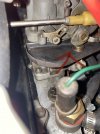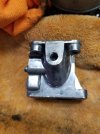GarageTimeTV
Garage Time TV
Hello everyone!
I am back for the final question (at least I hope). I have a 1968 850 Spider and when I want to accelerate, the throttle on my 30 DIC has what looks like a counter weight on it. When I try to open up full throttle, the arm rotates and hits the intake and won’t open the secondaries.
In other words, is there supposed to be a spacer under the carb so that it won’t hit? Or do I need to shave it down some to not hit.
I am back for the final question (at least I hope). I have a 1968 850 Spider and when I want to accelerate, the throttle on my 30 DIC has what looks like a counter weight on it. When I try to open up full throttle, the arm rotates and hits the intake and won’t open the secondaries.
In other words, is there supposed to be a spacer under the carb so that it won’t hit? Or do I need to shave it down some to not hit.


